Diurnal Variations in Surface Wind over the Tibetan Plateau
Abstract
:1. Introduction
2. Data and Methodology
3. Diurnal Variations in Wind Speed
4. Diurnal Variations in Surface Wind Directions and Diurnal Range of Wind Speed
5. Diurnal Cycle of Surface Winds in Different Zones
6. Summary and Discussion
- (1)
- The surface wind speed shows large diurnal variation. MAM has the highest wind speed and largest daily range of wind speed. On the TP, the minimum wind speed occurs in the early morning at 0600 LST and the maximum in the afternoon at 1500 LST. It is understandable that during daytime, as a response to surface solar heating, the downward vertical turbulent transport of momentum reaches its strongest in the afternoon. During night time, as a response to nocturnal cooling in the boundary layer, the eddy viscosity is reduced and less momentum is transported to the lower level. The surface wind slows down gradually due to the surface friction [21]. When the wind speed is high, the variation in wind speed is also large. On the TP the daily minimum wind speed arrives 1 h later than that recorded in eastern China by Yu et al. (2009) [21]. The two regions analyzed see the peak hourly wind speed in the same hour. The average daily range of wind speed on the TP is 2.4 m·s−1, nearly twice that in eastern China.
- (2)
- The surface winds were decomposed into meridional and zonal winds, and their diurnal variation analyzed. The south wind dominated the meridional winds in each season, accounting for more than two-thirds of each day. In the mornings during DJF and SON, the south wind changes to a north wind, changing back to a south wind in the afternoon. In JJA and SON, east and west winds alternate as the prevailing wind direction. During DJF and MAM, the average wind direction on the TP is easterly throughout the day.
- (3)
- The seasonal variation in the daily wind speed range of each station on the TP is well defined. The area of high diurnal range moved to the northwest with seasonal changes from DJF to MAM and from MAM to JJA. The hourly wind speed at 57% of the stations takes 8–10 h to develop from the lowest to the highest speed. At 79% of the stations the wind speed rises from the lowest to the highest in less time than it takes to change from the highest to the lowest.
- (4)
- The diurnal variation of wind speed over the TP is noticeable [13]. At 0600–0700 LST, 68% of the stations experienced their lowest wind speed, and 57% recorded their highest wind speeds at 1500 or 1600 LST. The lowest and highest daily wind speeds in the eastern part of the TP were recorded 1 h later than in the western part. The diurnal variation in surface winds in the Qaidam Basin differs significantly from that at the other plateau stations due to the blocking effect of the surrounding terrain. In addition to the hilly area, mountain-valley breeze can also occur on the edge of the plateau and the basin, and there is a significant diurnal variation in wind speed and wind direction. During the daytime, the wind often blows from the valley to the mountainside and the mountaintop. At nighttime, the wind often blows from the mountaintop and the mountainside to the valley. Based on decomposing the observed wind into the system wind and the mountain-valley breeze, researchers could carry out research on the diurnal variation of the surface wind and the mountain-valley breeze. This may contribute to analyzing the causes of diurnal variation of surface wind on the TP, however, more detailed mechanisms are to be further explored in future studies.
- (5)
- The EOF of the hourly wind speeds reflects the high wind speeds in the afternoon and lower wind speeds in the morning over most of the TP (except for the Qaidam Basin). It also reflects that the wind speed in the eastern part of the TP reaches a diurnal maximum later than that in the western part. It may be reasonable that EOF2 may be related to the different atmospheric circulation systems [25], topographic characteristics, snow cover and vegetation cover in the eastern and western parts of the TP.
Author Contributions
Funding
Acknowledgments
Conflicts of Interest
References
- Yang, G.-Y.; Slingo, J. The diurnal cycle in the tropics. Mon. Weather Rev. 2001, 129, 784–801. [Google Scholar] [CrossRef]
- Nesbitt, S.-W.; Zipser, E.-J. The diurnal cycle of rainfall and convective intensity according to three years of TRMM measurements. J. Clim. 2003, 16, 1456–1475. [Google Scholar] [CrossRef]
- Liu, C.-H.; Moncrieff, M.-W. A numerical study of the diurnal cycle of tropical oceanic convection. J. Atmos. Sci. 1998, 55, 2329–2344. [Google Scholar] [CrossRef]
- Bowman, K.-P.; Collier, J.-C.; North, G.-R.; Wu, Q.; Ha, E.; Hardin, J. Diurnal cycle of tropical precipitation in Tropical Rainfall Measuring Mission (TRMM) satellite and ocean buoy rain gauge data. J. Geophys. Res. 2005, 110, 1–14. [Google Scholar] [CrossRef]
- Zuidema, P. Convective clouds over the Bay of Bengal. Mon. Weather Rev. 2003, 131, 780–798. [Google Scholar] [CrossRef]
- Xiao, D.; Zhao, P.; Wang, Y.; Tian, Q.-H.; Zhou, X.-J. Millennial-scale phase relationship between North Atlantic deep-level temperature and Qinghai-Tibet Plateau temperature and its evolution since the Last Interglaciation. Chin. Sci. Bull. 2014, 59, 75–81. [Google Scholar] [CrossRef]
- Nan, S.-L.; Zhao, P.; Chen, J.-M. Variability of summertime Tibetan tropospheric temperature and associated precipitation anomalies over the central-eastern Sahel. Clim. Dyn. 2018. [Google Scholar] [CrossRef]
- Guo, H.; Xu, M.; Hu, Q. Changes in near-surface wind speed in China: 1969–2005. Int. J. Climatol. 2011, 31, 349–358. [Google Scholar] [CrossRef]
- Fu, Z.-T.; Li, Q.-L.; Yuan, N.-M.; Yao, Z.-H. Multi-scale entropy analysis of vertical wind-speed series in atmospheric boundary-layer. Commun. Nonlinear Sci. 2014, 19, 83–91. [Google Scholar] [CrossRef]
- Guo, X.-Y.; Wang, L.; Tian, L.-D.; Li, X.-P. Elevation-dependent reductions in wind speed over and around the Tibetan Plateau. Int. J. Climatol. 2017, 37, 1117–1126. [Google Scholar] [CrossRef]
- Chen, S.-B.; Liu, Y.-F.; Thomas, A. Climatic change on the Tibetan Plateau: Potential evapotranspiration trends from 1961–2000. Clim. Chang. 2006, 76, 291–319. [Google Scholar]
- Dai, A.-G. Global precipitation and thunderstorm frequencies. Part II: Diurnal variations. J. Clim. 2001, 14, 1112–1128. [Google Scholar] [CrossRef]
- Dai, A.-G.; Deser, C. Diurnal and semidiurnal variations in global surface wind and divergence fields. J. Geophys. Res. 1999, 104, 109–126. [Google Scholar] [CrossRef]
- Murakami, M. Analysis of the deep convective activity over the Western Pacific and Southeast Asia. Part I: Diurnal variation. J. Meteorol. Soc. Jpn. 1983, 61, 60–76. [Google Scholar] [CrossRef]
- Bhatt, B.-C.; Nakamura, K. Characteristics of monsoon rainfall around the Himalayas revealed by TRMM precipitation Radar. Mon. Weather Rev. 2005, 133, 149–165. [Google Scholar] [CrossRef]
- Liu, L.-P.; Feng, J.-M.; Chu, R.-Z.; Zhou, J.-J. The diurnal variation of precipitation in Monsoon season in the Tibetan Plateau. Adv. Atmos. Sci. 2002, 19, 365–378. [Google Scholar]
- Bai, A.-J.; Liu, C.-H.; Liu, X.-D. Diurnal variation of summer rainfall over the Tibetan Plateau and its neighboring regions revealed by TRMM Multisatellite Precipitation Analysis. Chin. J. Geophys. 2008, 51, 704–714. (In Chinese) [Google Scholar] [CrossRef]
- Zhao, Y.-F.; Zhang, Q.; Yu, Y.; Yang, G. Development of hourly wind speed dataset in China and application on Qinghai Tibetan Plateau. Plat. Meteorol. 2017, 36, 930–938. [Google Scholar]
- Zhang, W.-J.; Jin, F.-F.; Zhao, J.-X.; Li, J.-P. On the bias in simulated ENSO SSTA meridional width of CMIP3 models. J. Clim. 2013, 26, 3173–3186. [Google Scholar] [CrossRef]
- He, W.-P.; Zhao, S.-S. Assessment of the quality of NCEP-2 and CFSR reanalysis daily temperature in China based on long-range correlation. Clim. Dyn. 2018, 50, 493–505. [Google Scholar] [CrossRef]
- Yu, R.-C.; Li, J.; Chen, H.-M. Diurnal variation of surface wind over central eastern China. Clim. Dyn. 2009, 33, 1089–1097. [Google Scholar] [CrossRef]
- Crawford, K.-C.; Hudson, H.-R. The diurnal wind variation in the lowest 1500 ft in Central Oklahoma: June 1966–May 1967. J. Appl. Meteorol. 1973, 12, 127–132. [Google Scholar] [CrossRef]
- North, G.-R.; Bell, T.-L.; Cahalan, R.-F.; Moeng, F.-J. Sampling errors in the estimation of empirical orthogonal functions. Mon. Weather Rev. 1982, 110, 699–706. [Google Scholar] [CrossRef]
- Qin, Q.-C.; Shen, X.-S. An estimate of surface pressure drag of the Tibetan Plateau and its characteristic analysis. Acta. Meteorol. Sin. 2015, 73, 93–109. (In Chinese) [Google Scholar]
- Yang, K.; Wu, H.; Qin, J.; Lin, C.-G.; Tang, W.-J.; Chen, Y.-Y. Recent climate changes over the Tibetan Plateau and their impacts on energy and water cycle: A review. Glob. Planet Chang. 2014, 112, 79–91. [Google Scholar] [CrossRef]
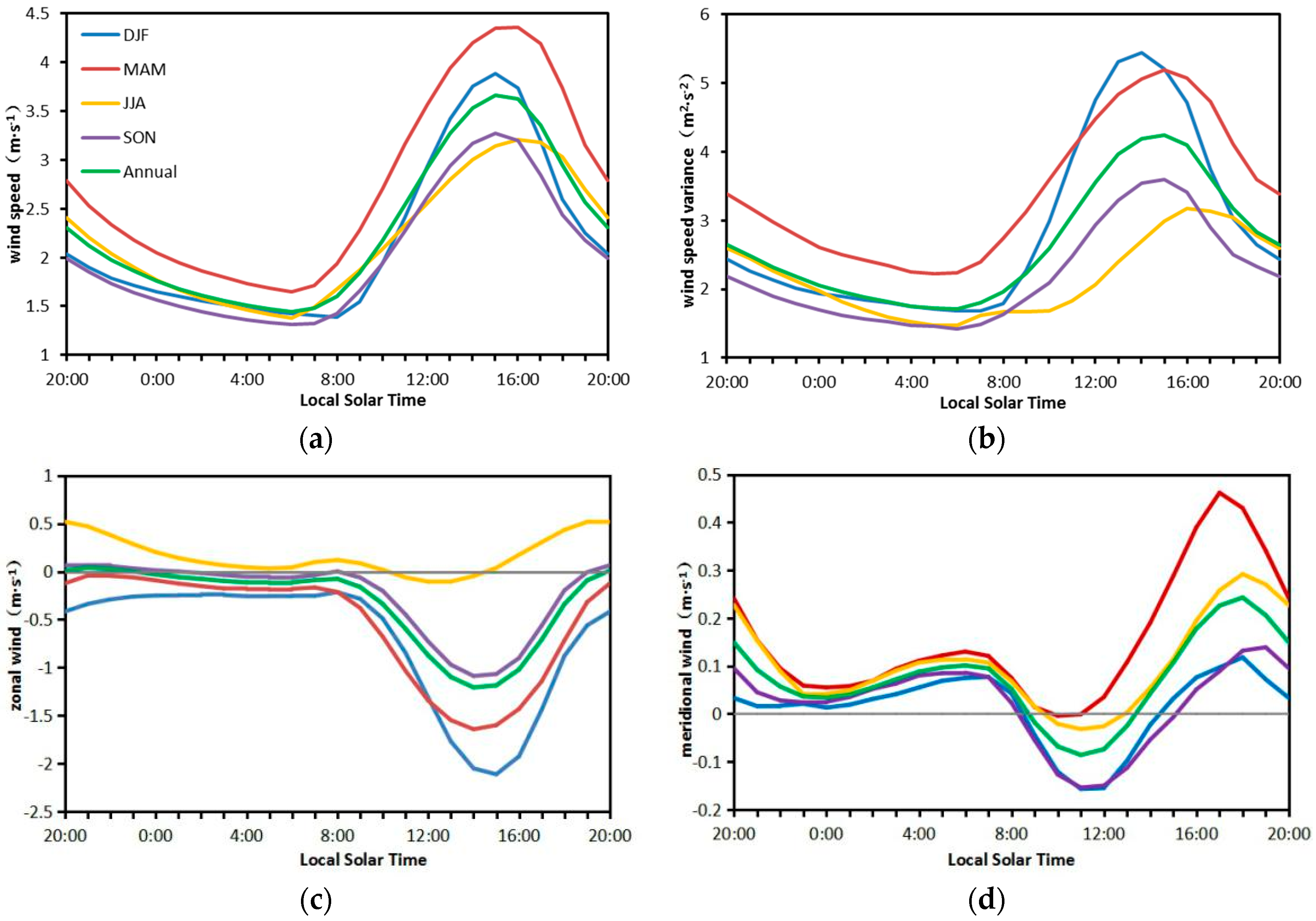
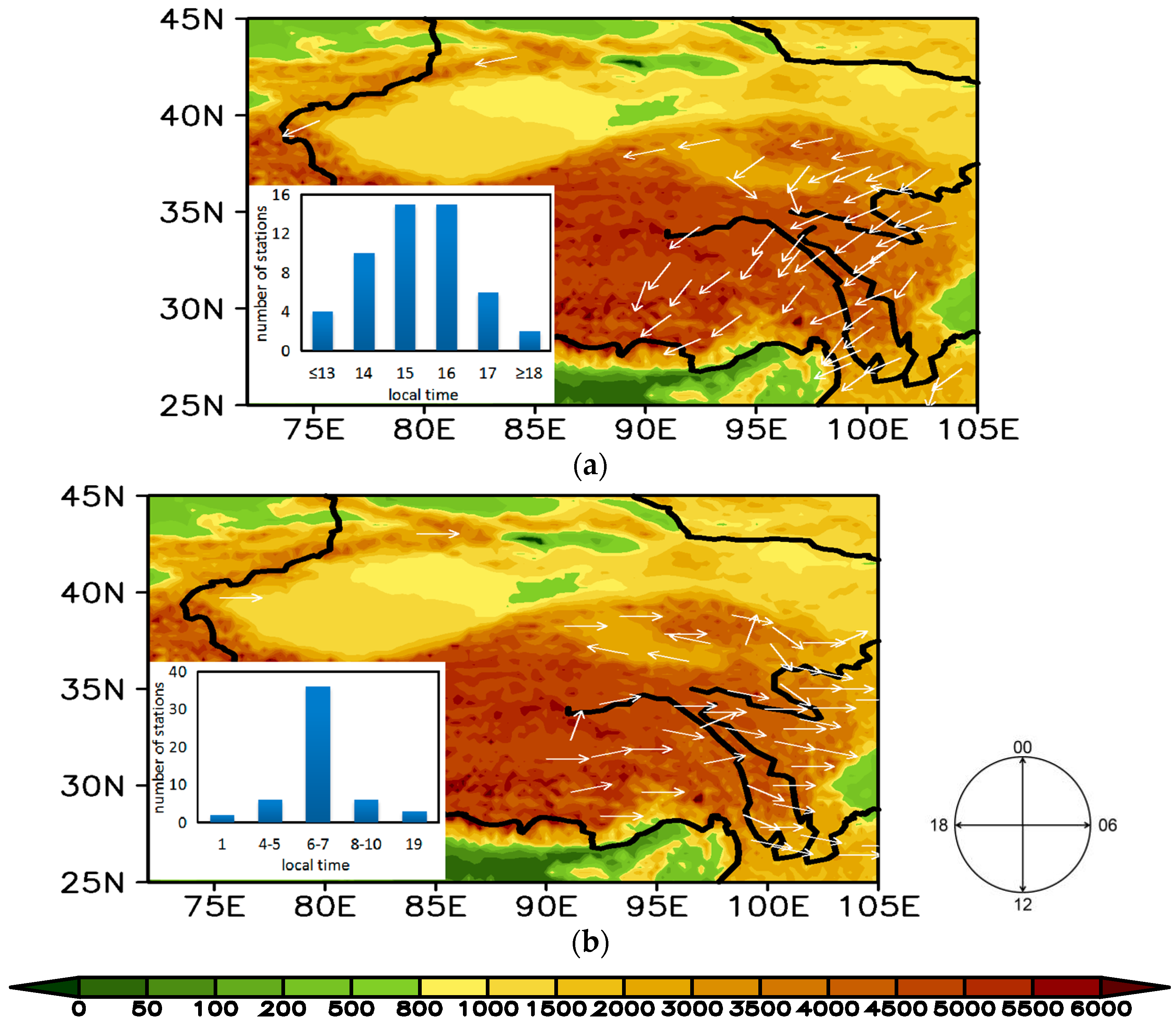
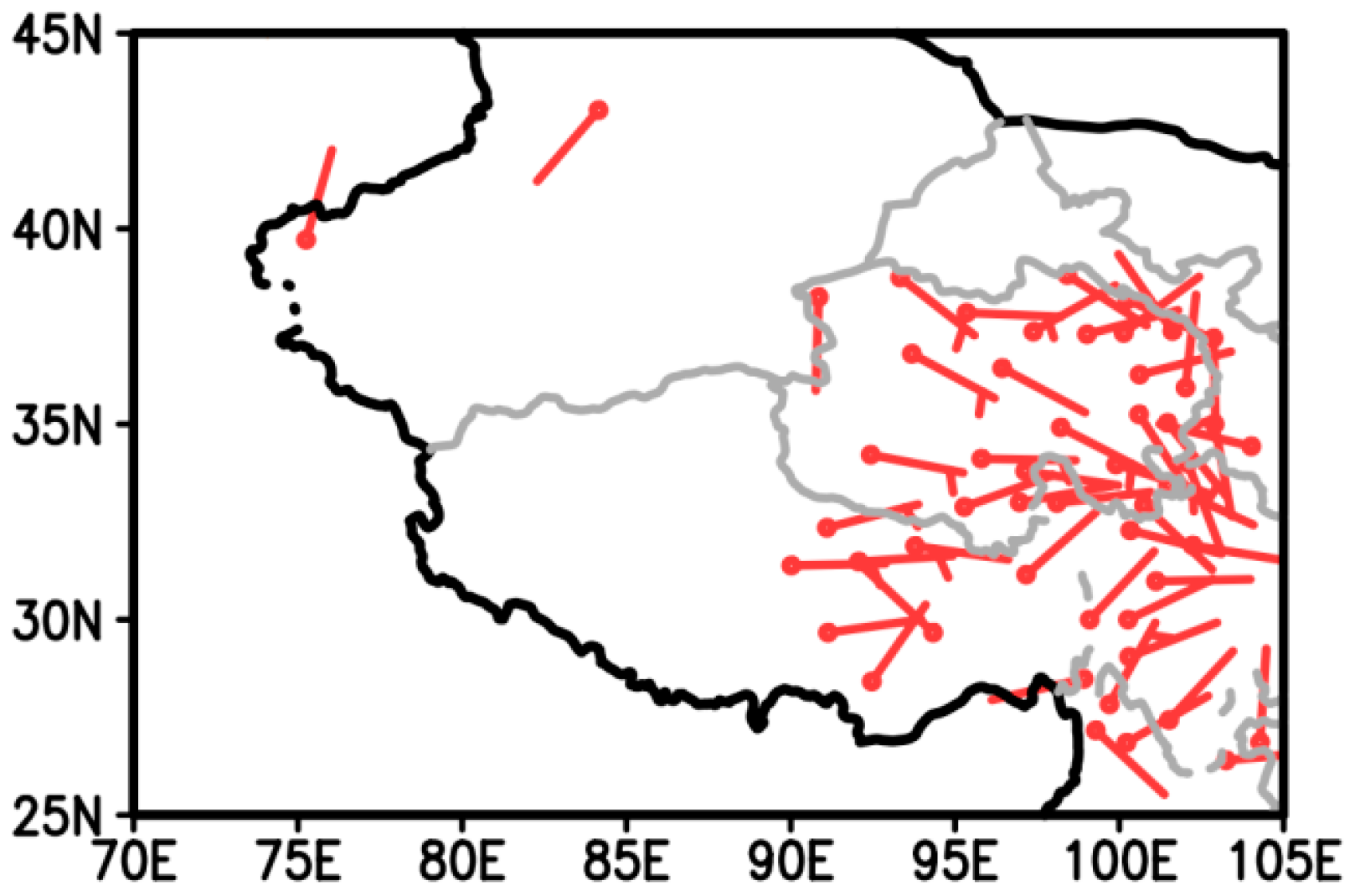
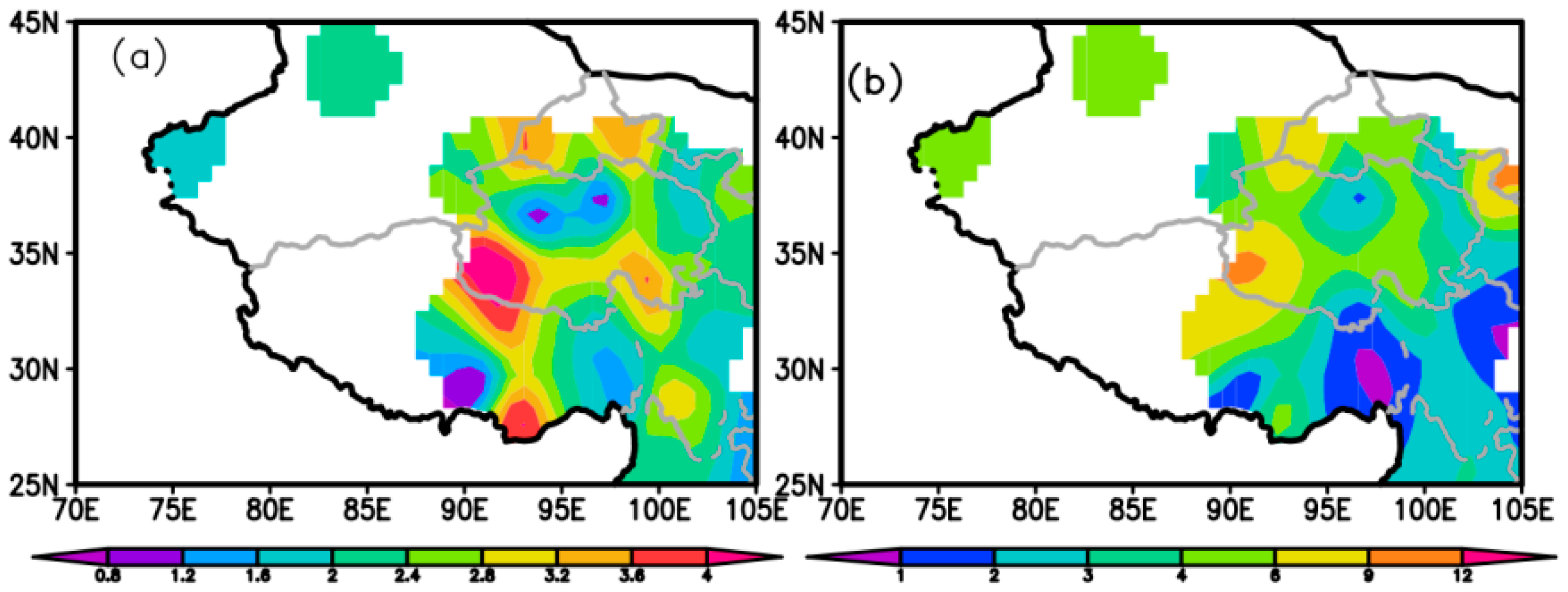


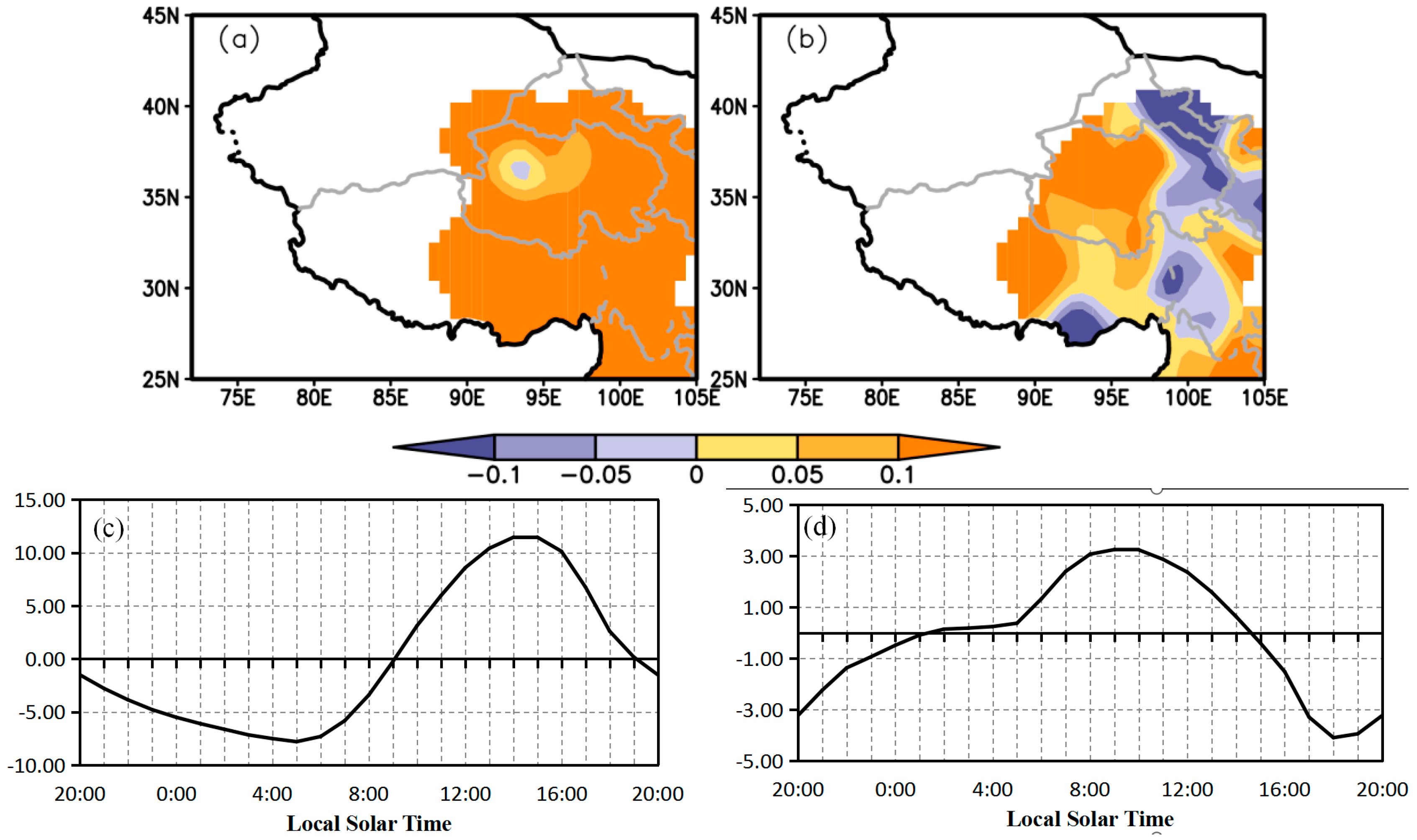
| Number of hours | 6 | 7 | 8 | 9 | 10 | 11 | 12 | 13 | 14 | 15 | 16 | 19 |
| Number of stations | 2 | 5 | 9 | 14 | 11 | 5 | 2 | 1 | 1 | 1 | 1 | 1 |
| Percentage (%) | 3.8 | 9.4 | 17.0 | 26.4 | 20.8 | 9.4 | 3.8 | 1.9 | 1.9 | 1.9 | 1.9 | 1.9 |
| Wind Direction | The Numbers of Stations | ||
|---|---|---|---|
| Max-Dir | Min-Dir | Average Wind Direction | |
| Northeast | 24 | 10 | 17 |
| Southeast | 22 | 19 | 22 |
| Northwest | 4 | 15 | 6 |
| Southwest | 3 | 9 | 8 |
© 2019 by the authors. Licensee MDPI, Basel, Switzerland. This article is an open access article distributed under the terms and conditions of the Creative Commons Attribution (CC BY) license (http://creativecommons.org/licenses/by/4.0/).
Share and Cite
Zhao, Y.; Li, J.; Zhang, Q.; Jiang, X.; Feng, A. Diurnal Variations in Surface Wind over the Tibetan Plateau. Atmosphere 2019, 10, 112. https://doi.org/10.3390/atmos10030112
Zhao Y, Li J, Zhang Q, Jiang X, Feng A. Diurnal Variations in Surface Wind over the Tibetan Plateau. Atmosphere. 2019; 10(3):112. https://doi.org/10.3390/atmos10030112
Chicago/Turabian StyleZhao, Yufei, Jianping Li, Qiang Zhang, Xiaowei Jiang, and Aixia Feng. 2019. "Diurnal Variations in Surface Wind over the Tibetan Plateau" Atmosphere 10, no. 3: 112. https://doi.org/10.3390/atmos10030112
APA StyleZhao, Y., Li, J., Zhang, Q., Jiang, X., & Feng, A. (2019). Diurnal Variations in Surface Wind over the Tibetan Plateau. Atmosphere, 10(3), 112. https://doi.org/10.3390/atmos10030112




